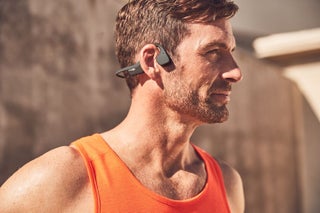New perk! Get after it with local recommendations just for you. Discover nearby events, routes out your door, and hidden gems when you sign up for the Local Running Drop.
Aftershokz’s latest offering, the Trekz Air, uses bone conduction technology that lets athletes listen to their music without interfering with their awareness.
Like most people who run or ride outdoors, the activity is rarely a solitary one. Running on busy sidewalks, riding on roads alongside cars, even running on desolate trails often requires a certain measure of awareness just to stay safe. In an effort to keep every sense sharp, many triathletes choose to forego their favorite music so as not to plug their ears and take one of those senses out of the equation.
Though the technology is not brand new, bone conduction headphones still seem to be an outlier in the sports audio world. Used most commonly in hearing aids, bone conduction tech uses tiny mechanical vibrations to entirely bypass the outer and inner ear, sending signals through the cranial (or jaw) bone into the inner ear instead of the ear drum. Your ears remain unplugged and still able to hear the outside world.
In the last 30 years, the idea made its way into other applications aside from hearing aids: Scuba divers have great success with bone conduction underwater; also the military has used the tech in order to retain environmental awareness while keeping in constant communication. Even Google used bone conduction technology on their ill-fated Google Glass when it was released back in 2013.
A few years ago, Aftershokz made a big effort by switching their military focus towards consumer athletics; since then their Trekz Titanium has been one of the better wireless options for triathletes. Though the experience is definitely different than normal earbuds or over-ear headphones, their latest upgrade, the Trekz Air, improves upon a lot of the things that made bone conduction a series of compromises.
We take a look at the ups and downs of the Trekz Air and bone conduction audio:
 Pros:
Pros:
- Bone conduction obviously leaves the ear drum free to hear the world around you, so situational awareness is much much better—even at full volume—than any earbud. This was by far the most comfortable, safety-wise, we’ve ever felt while training and listening to music.
- With that said, the Trekz Air also has a very useful large, single-touch button on the left side that quickly pauses playing (among other functions) for times when you need quick, easy silence.
- Sound quality is much improved over the Trekz Titanium. Bass sounds better without getting too buzzy (a sensation that takes some getting used to, more on that later). We never got any lapses with the strong Bluetooth connection either.
- Lighter weight over the last version means less bouncing while running and gives the impression after a few minutes that you’re wearing something more like a headband than headphones.
- Microphone quality while taking calls is actually incredible—something we didn’t expect.
- Battery is also surprisingly good (six hours plus), given the mechanics involved.
Cons:
- Perhaps because of signal strength that’s needed to power the audio drivers, volume often needs to be pretty high to get good, loud sound outside.
- The vibrations can take some getting used to—less in a running/riding scenario when you’re moving, but more in a stationary setting. Some tracks with lots of sound can “buzz” your skull a little bit. It’s not enough to be uncomfortable, but it is different.
- Sound quality is good, but not amazing. For sports, these sound just fine.
- Though bone conduction works great underwater, Bluetooth doesn’t, so these can’t be used for swimming. While this isn’t the fault of the product, it sort of seems like a missed opportunity. Regardless, we found these sweat resistant enough to get quite wet.
- Outward sound leakage is still a small issue (more for a library situation than for sports), but the Air does a much better job managing it than the Titanium did.
The Verdict:
We liked the old Titanium, but found some of the inherent issues with bone conduction to take some getting used to. Fortunately, the Air has smoothed out most of our complaints. If you’re going to listen to music while training (bear in mind, USAT rules do not allow “headphones, headsets, walkmans, ipods, mp3 players, or personal audio devices, etc.” during races), this is by far the safest option. You can still expect to hear cars going by, the sound of people speaking, and even the sound of knobby tires on trails at certain volumes—all of which is very important for staying safe. While Trekz does include ear plugs to effectively close off outside sound for a fully immersive experience, if that’s what you’re looking for, these might not be a good fit. With that said, these are definitely the best headphones for people who want to listen to music and still keep all of their senses intact.
$150, Available for pre-order at Trekzair.aftershokz.com

